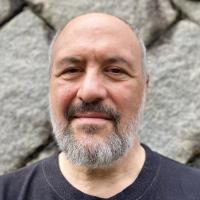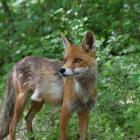“Large mammals thrive in the Red Forest,” proclaimed science writer Erin Kelly in 2022. “From elk to boars to dogs, Chernobyl’s animals have found an unexpected haven for wildlife in the Red Forest of the Exclusion Zone.” Kelly’s story followed a spate of articles trumpeting the fact that the numbers of mammals observed in the Chernobyl Exclusion Zone (CEZ) have increased since it was declared off limits to human beings.
These articles were in response to footage taken from biologists’ field cameras, which documented the presence of large mammals not typically seen in the Zone, like wolves and bears. The resulting studies that supported the narrative of recovery did not offer rigorous surveys of species populations or measurements of time spent within the contaminated Zone, but the footage was nevertheless used to invoke a healthy ecosystem. Many newspaper and magazine articles used it as the basis for claims that ecosystems could recover from radiological contamination “naturally.”
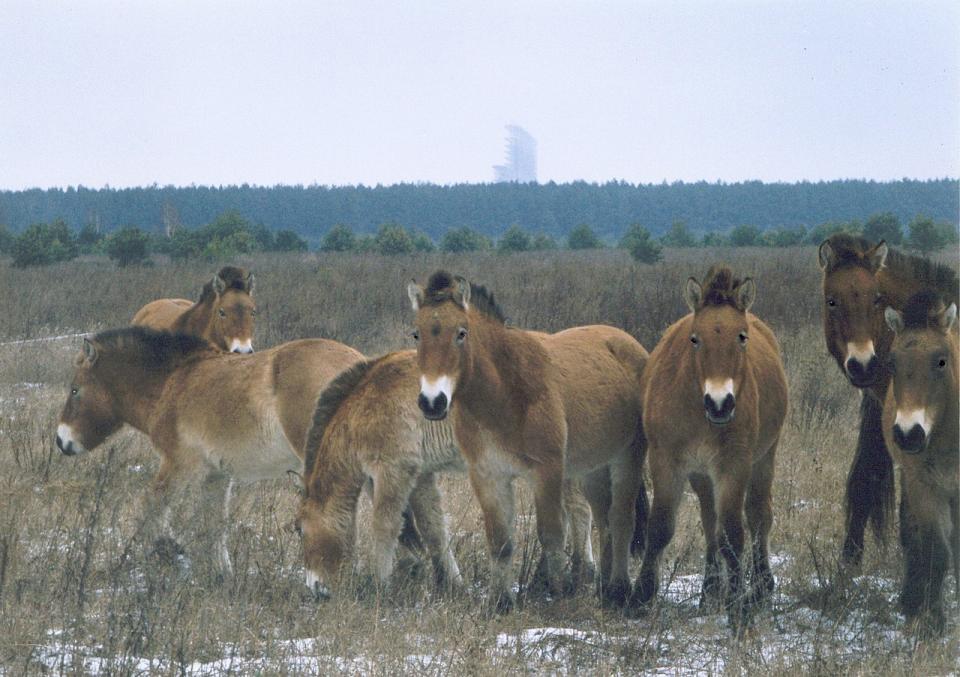
Prewalski horses in the Chernobyl Exclusion Zone. These were introduced after the nuclear accident to assist in the rewilding of the ecosystem.
Prewalski horses in the Chernobyl Exclusion Zone. These were introduced after the nuclear accident to assist in the rewilding of the ecosystem.
Photograph by Xopc. Click here to view source.
 This work is licensed under a Creative Commons Attribution-ShareAlike 2.5 Generic License.
This work is licensed under a Creative Commons Attribution-ShareAlike 2.5 Generic License.
Recently, a more problematic species of large mammal has been seen in the CEZ; news reports about these animals took a starkly different stance. In the early days of the Russian invasion of Ukraine, Reuters warned that “Russian soldiers who seized the site of the Chernobyl nuclear disaster drove their armoured vehicles without radiation protection through a highly toxic zone called the ‘Red Forest,’ kicking up clouds of radioactive dust.” For these mammals, such news stories declared, the consequences were swift and severe. The Independent proclaimed that “Russian soldiers stationed in the forest have since been struck down with radiation sickness, diplomats have confirmed. Symptoms can start within an hour of exposure and can last for several months, often resulting in death.”
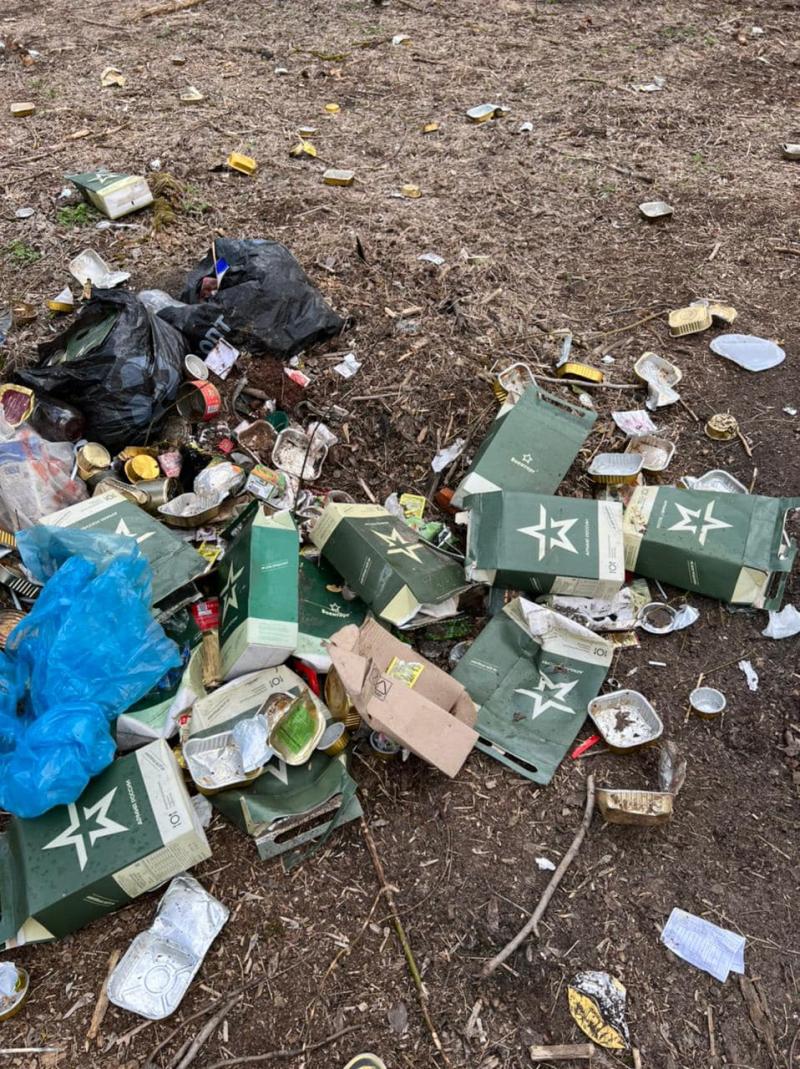
Packages of Russian field ration left at the Red Forest.
Packages of Russian field ration left at the Red Forest.
Photograph by the State Border Guard Service of Ukraine. Click here to view source.
 This work is licensed under a Creative Commons Attribution 4.0 International License.
This work is licensed under a Creative Commons Attribution 4.0 International License.
Other stories quickly built on this narrative. The Telegraph stated that “Radiation from the destroyed Chernobyl nuclear plant in Ukraine has reportedly killed one Russian soldier after his unit camped in a toxic area known as the Red Forest.” British Metro reported how “Russian troops withdrawn from the Chernobyl nuclear power site are being rushed across the border to a special medical facility in Belarus with ‘acute radiation sickness.’” According to The Daily Beast, “Journalists on the ground … also reported ‘ghost buses’ of dead soldiers being transported from Belarus to Russia under the cover of dark.” Because of the war, these claims have not been verified; however, it is unlikely that the exposure these troops had would have resulted in piles of dead bodies in such a short time—it rather would result in the kindling of cancers that would present in the future.
Despite the radically different reportage, the behavior of the nonhuman animals was similar to that of the troops: they dug in the contaminated soil of the Red Forest and fed on the plants and other animals. For nonhumans, this attested to the healing power of nature in media coverage; for human beings, it was seemingly catastrophic.
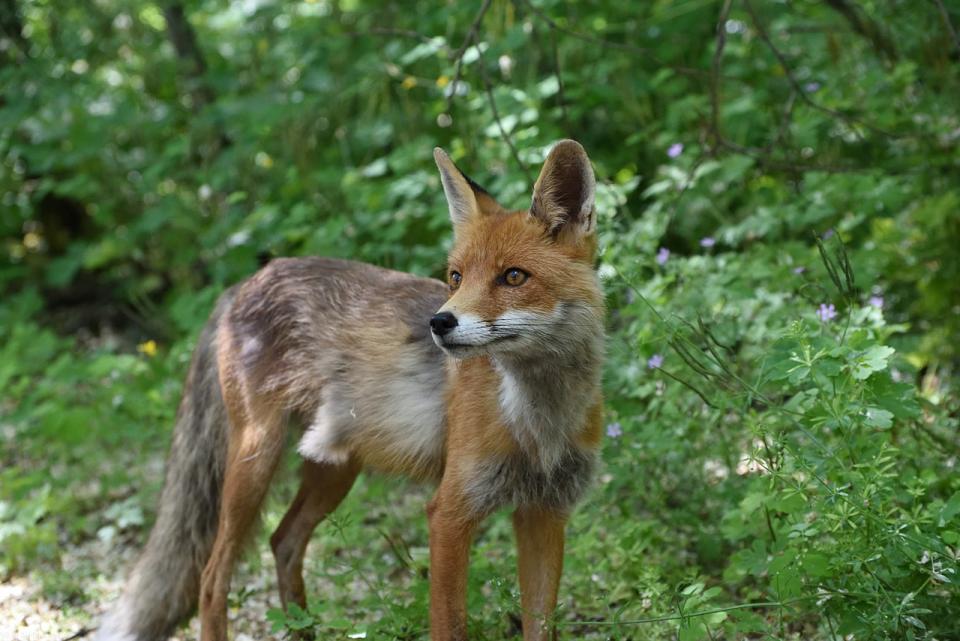
A fox in the Chernobyl Exclusion Zone, in the wild.
A fox in the Chernobyl Exclusion Zone, in the wild.
Photograph by Vic Harkness, 2016. Click here to view source.
 This work is licensed under a Creative Commons Attribution-ShareAlike 2.0 Generic License.
This work is licensed under a Creative Commons Attribution-ShareAlike 2.0 Generic License.
Debates about harm from radiation exposure have been fraught, and we can see this reflected in the discourse around mammals in the CEZ. There are two lines of dispute: One focuses on how levels of exposure to external radiation correlate with radiogenic illnesses. The other involves the distinction between external and internal exposures.
Many biologists rely on readings of external levels of gamma radiation to assess risk and harm, utilizing the Life Span Study (LSS). The LSS was based on models developed following the nuclear attacks on Hiroshima and Nagasaki, where study participants experienced a single high-dose exposure to external radiation. More pertinent here is the recent groundbreaking work of the INWORKS study of long-term low-dose exposures to external radiation, which found significantly elevated cancer incidence compared to the LSS. The INWORKS study has yet to be engaged by biologists focused on external exposures in the CEZ.
This risk-assessment model does not include harm resulting from internalizing individual radionuclides. These fallout particles have dispersed into the ecosystem, and are unevenly distributed, and hence result in a stochastic presentation of disease. After years of study in the CEZ, biologists Ronald Chesser and Robert Baker concluded that “we must examine the internal and external doses for each individual, rather than relying on population averages or the animal’s proximity to the reactor.”
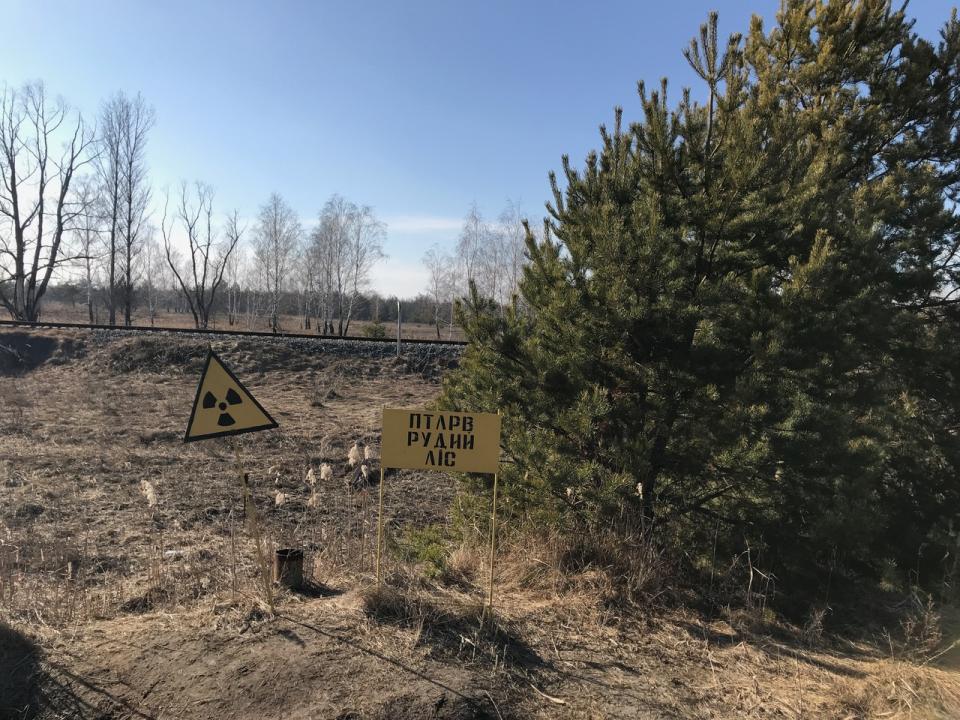
Radiation sign in the Chernobyl Exclusion Zone.
Radiation sign in the Chernobyl Exclusion Zone.
Photograph by Robert Jacobs, 2019.
 This work is licensed under a Creative Commons Attribution 4.0 International License.
This work is licensed under a Creative Commons Attribution 4.0 International License.
The disputes offer a menu of risk and harm from which to choose. The radiobiological uncertainties of the Red Forest present a green screen where we can project our utopic and dystopic responses to nuclear technologies—fears and fantasies about the long-term consequences of radiological disasters. In 2011, geneticist Barry Starr invoked a stark human/wildlife divide regarding the potential for radiobiological harm: “though the area around Chernobyl is still so contaminated that humans can only go in for limited amounts of time, the wildlife appears to be doing surprisingly well.” Starr’s is a Chernobyl version of the fictional law—from George Orwell’s Animal Farm—that proclaims “all animals are equal, but some animals are more equal than others.” When humans flee a location and the territories of other creatures expand, this does not demonstrate an absolute difference in biological risk, just a shift in which species are being harmed. Whether the recognition of ongoing risk prompted by human presence in the Zone will extend to nonhuman animals remains to be seen.
For redemptive stories about the recovery of the Red Forest to be successful, humans must remain behind the cameras. With the Russian invasion, humans were back onscreen, and so “Chernobyl” again connotes a disaster site. A place lost to humans, then occupied by brutish troops who will have to pay a personal price for their violation. The human argument over what they see when they look at Chernobyl will fade as the observers give way to a new generation of observers. However, the radiological contamination will endure long past the lifespans of these observers. The contamination is long-term, our politics are of the moment.
Primary Sources
- Atkinson, Emily. “Russian forces suffer radiation sickness after digging trenches and fishing in Chernobyl.” The Independent, 1 May 2023. https://www.independent.co.uk/news/world/europe/red-forest-chernobyl-radiation-sickness-b2330067.html/.
- Corbishley, Sam. “Dozens of Russian troops ‘fall ill with radiation poisoning’ at Chernobyl.” Metro, 31 March 2022. https://metro.co.uk/2022/03/31/chernobyl-withdrawn-russian-troops-suffering-radiation-poisoning-16377485/.
- “How Chernobyl Has Become an Unexpected Haven for Wildlife.” United Nations Environment Programme, 16 September 2020. https://www.unep.org/news-and-stories/story/how-chernobyl-has-become-unexpected-haven-wildlife/.
- Kelly, Erin. “Why The Animals Of Chernobyl Thrive In The Exclusion Zone.” All That is Interesting, 18 February 2022. https://allthatsinteresting.com/chernobyl-animals/.
- Nadeau, Barbie Latza. “Russian Troops Suffer ‘Acute Radiation Sickness’ after Digging Chernobyl Trenches.” The Daily Beast, 31 March 2022. https://www.thedailybeast.com/russian-troops-suffer-acute-radiation-sickness-after-digging-chernobyl-trenches/.
- Starr, Barry. “The Benefits of Radioactive Fallout.” KQED, 9 January 2012. https://www.kqed.org/quest/29086/the-benefits-of-radioactive-fallout/.
- “Unprotected Russian Soldiers Disturbed Radioactive Dust in Chernobyl’s ‘Red Forest,’ Workers Say.” Reuters, 29 March 2022. https://www.reuters.com/world/europe/unprotected-russian-soldiers-disturbed-radioactive-dust-chernobyls-red-forest-2022-03-28/.
How to cite
Jacobs, Robert. “Four Legs Good, Two Legs Bad: Animals Return to the Chernobyl Exclusion Zone.” Environment & Society Portal, Arcadia (Autumn 2023), no. 21. Rachel Carson Center for Environment and Society. doi:10.5282/rcc/9700.
ISSN 2199-3408
Environment & Society Portal, Arcadia
 This work is licensed under a Creative Commons Attribution 4.0 International License.
This work is licensed under a Creative Commons Attribution 4.0 International License.
2023 Robert Jacobs
This refers only to the text and does not include any image rights.
Please click on an image to view its individual rights status.
- Brown, Kate. Manual for Survival: A Chernobyl Guide to the Future. New York: W.W. Norton & Company, 2019.
- Chesser, Ronald K., and Robert J. Baker. “Growing up with Chernobyl: Working in a Radioactive Zone, Two Scientists Learn Tough Lessons about Politics, Bias and the Challenges of Doing Good Science.” American Scientist 94 (2006): 542–9.
- Jacobs, Robert A. Nuclear Bodies: The Global Hibakusha. New Haven: Yale University Press, 2022.
- Klüppelberg, Achim. “Chernobyl as a Post-Soviet Memory Space: How Ideas of Progress and Fear Shaped a Nuclear Heritage Site.” Baltic Worlds 3, no. 4 (2023): 61–5.
- Mousseau, Timothy A., and Anders P. Møller. “Biological Consequences of Chernobyl: 20 Years On.” Trends in Ecology and Evolution 21, no. 4 (2006): 200–207.
- Mousseau, Timothy A., and Anders P. Møller. “Genetic and Ecological Studies of Animals in Chernobyl and Fukushima.” Journal of Heredity 105, no. 5 (2014): 704–9.
- Richardson, David B., Klervi Leuraud, Dominique Laurier, Michael Gillies, Richard Haylock, Kaitlin Kelly-Reif, Stephen Bertke, Robert D. Daniels, Isabelle Thierry-Chef, Monika Moissonnier, Ausrele Kesminiene, and Mary K. Schubauer-Berigan. “Cancer Mortality after Low Dose Exposure to Ionising Radiation in Workers in France, the United Kingdom, and the United States (INWORKS): Cohort Study.” British Medical Journal 382 (2023): 1–12.


